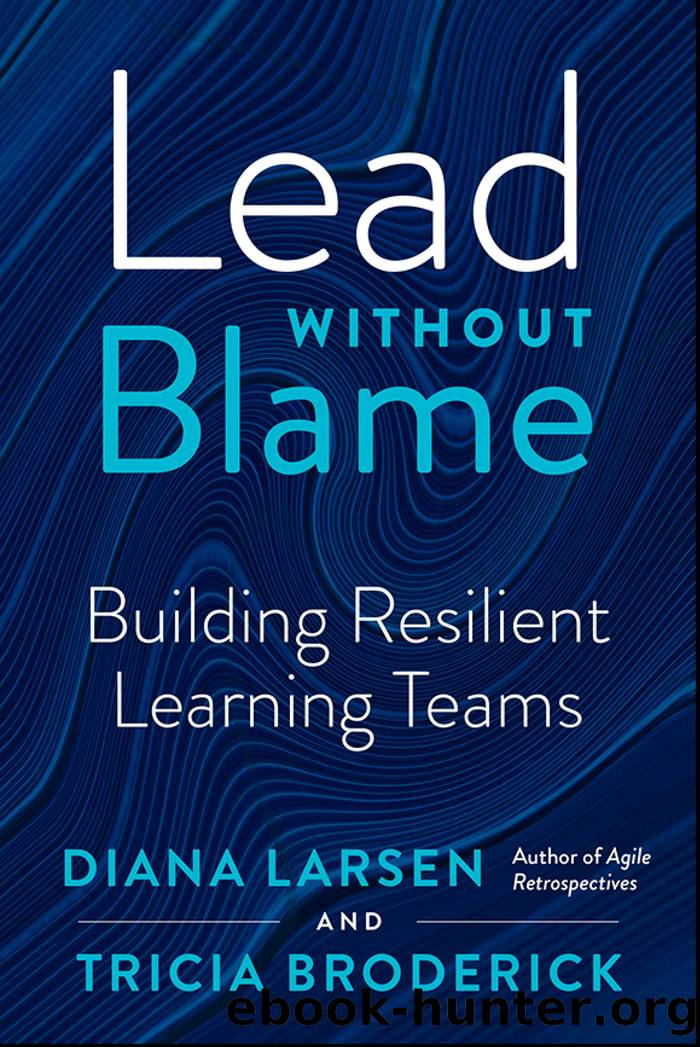Lead Without Blame by Diana Larsen

Author:Diana Larsen
Language: eng
Format: epub
Publisher: Berrett-Koehler Publishers
Behavior Challenges
Challenges inevitably arise with cooperative and collaborative work. The framing of conflict challenges frequently has a similar structure: How do I <stop, manage, address, etc.> <person(s)> from <negative behavior(s)>?
People seek resolutions that address the issue specifically with the problem person. But that is based on an assumption that the individual displaying this behavior is the problem. Learning leaders start with a focus on the setting that enables the behavior to occur.
For example, an influential team member may get labeled âbossy.â They speak way too much and make all the decisions in the retrospective. A common reaction is to call this person a âjerkâ and gossip about their control issues. What if they hate inefficient meetings and think they are helping by moving things along? When we only interact with critiques about their behavior, we limit the learning opportunities.
An operations director asked an HR leader, Lin, for feedback. The director expressed concerns about his operational managers. He was upset with their lack of engagement. Lin spoke with the six operational managers. They all mentioned their discomfort with the new director. They called him âa typical pointy-haired boss.â To them, he seemed detached and only out for his own career, not for the good of the department or the company.
Trying to understand the bigger system, Lin dug deeper. The director role had recently been created as a condition of funding by a major investor. Heâd been hired only a few months before. Previously, the operation managers reported directly to the vice president of operations. Now the director reported to the vice president. In the managersâ perspectives, the director intentionally blocked their connection to decision makers. Lin heard that the director made decisions that overrode what the teams needed. The operational managers thought he was blocking progress, and started limiting interactions to reduce frustration. From the directorâs perspective, he was doing his job. He believed he didnât need to understand the past; he was supposed to create a new, higher-performing future. He was trying to make progress.
Also, Lin learned that the director was rarely present. Three weeks after his onboarding, the director was pulled away to deal with family issues. When he came back, he was quickly pulled away again, this time for an off-site quarterly reporting session with the investors. This was followed by his accompanying the directors of product and sales to several key customer meetings. Yet he knew that if he didnât get quick results, he could lose his job and the company could lose funding. To keep things moving, he had to make a few fast decisions.
Lin perceived how each individual saw the problem from the perspective of their own needs. Yet it was a systemic issue. Changes had occurred in their work system. They couldnât go back to the old way, but they hadnât yet discovered a new, more effective way to work as a team. They were stuck in the middle of this change, and they needed to learn their way out.
When Lin gave an overview of her observations to the director, he was stunned.
Download
This site does not store any files on its server. We only index and link to content provided by other sites. Please contact the content providers to delete copyright contents if any and email us, we'll remove relevant links or contents immediately.
Hit Refresh by Satya Nadella(8362)
The Compound Effect by Darren Hardy(7621)
Change Your Questions, Change Your Life by Marilee Adams(6687)
Nudge - Improving Decisions about Health, Wealth, and Happiness by Thaler Sunstein(6669)
The Black Swan by Nassim Nicholas Taleb(6239)
Daring Greatly by Brene Brown(5680)
Deep Work by Cal Newport(5552)
Principles: Life and Work by Ray Dalio(5361)
Rich Dad Poor Dad by Robert T. Kiyosaki(5191)
The Myth of the Strong Leader by Archie Brown(4810)
Man-made Catastrophes and Risk Information Concealment by Dmitry Chernov & Didier Sornette(4788)
Big Magic: Creative Living Beyond Fear by Elizabeth Gilbert(4764)
The Slight Edge by Jeff Olson(4746)
Discipline Equals Freedom by Jocko Willink(4659)
Digital Minimalism by Cal Newport;(4619)
The Motivation Myth by Jeff Haden(4556)
Stone's Rules by Roger Stone(4440)
Management Strategies for the Cloud Revolution: How Cloud Computing Is Transforming Business and Why You Can't Afford to Be Left Behind by Charles Babcock(4150)
The Doodle Revolution by Sunni Brown(4068)
